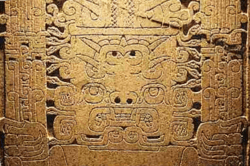Raimondi Stela
The Indigenous deity of the Chavin civilization known as Raimondi Stela is a sacred object and a major piece of art of the Chavín culture of the central Andes in present-day Peru. The stela is seven feet high, made of highly polished granite, with a lightly incised design which is almost unnoticeable on the sculpture. For this reason, the design is best studied from a drawing. It is housed in the courtyard of the Museo Nacional de Arqueología Antropología e Historia del Perú in Lima.

Chavin artists frequently used the technique of contour rivalry in their art forms, and this indigenous deity is considered one of the finest known examples of this technique. Contour rivalry means that the lines in an image can be read in multiple ways, depending on which way the object is being viewed. When the Raimondi Stela is viewed one way, the image depicts a fearsome deity holding two Huachuma cactus. His eyes look upward toward his large, elaborate headdress of snakes and volutes. When flipped upside-down, the same image can be seen differently. The headdress can be "read" as a stacked row of smiling, fanged faces, while the deity's face has turned into the face of a smiling reptile. The deity's staffs also appear to be rows of stacked faces.
This technique speaks to larger Andean concerns of the duality and reciprocal nature of nature, life, and society. This theme is found in the art of many other Andean indigenous civilizations.
See also
External links
- Raimondi Stela Full Image